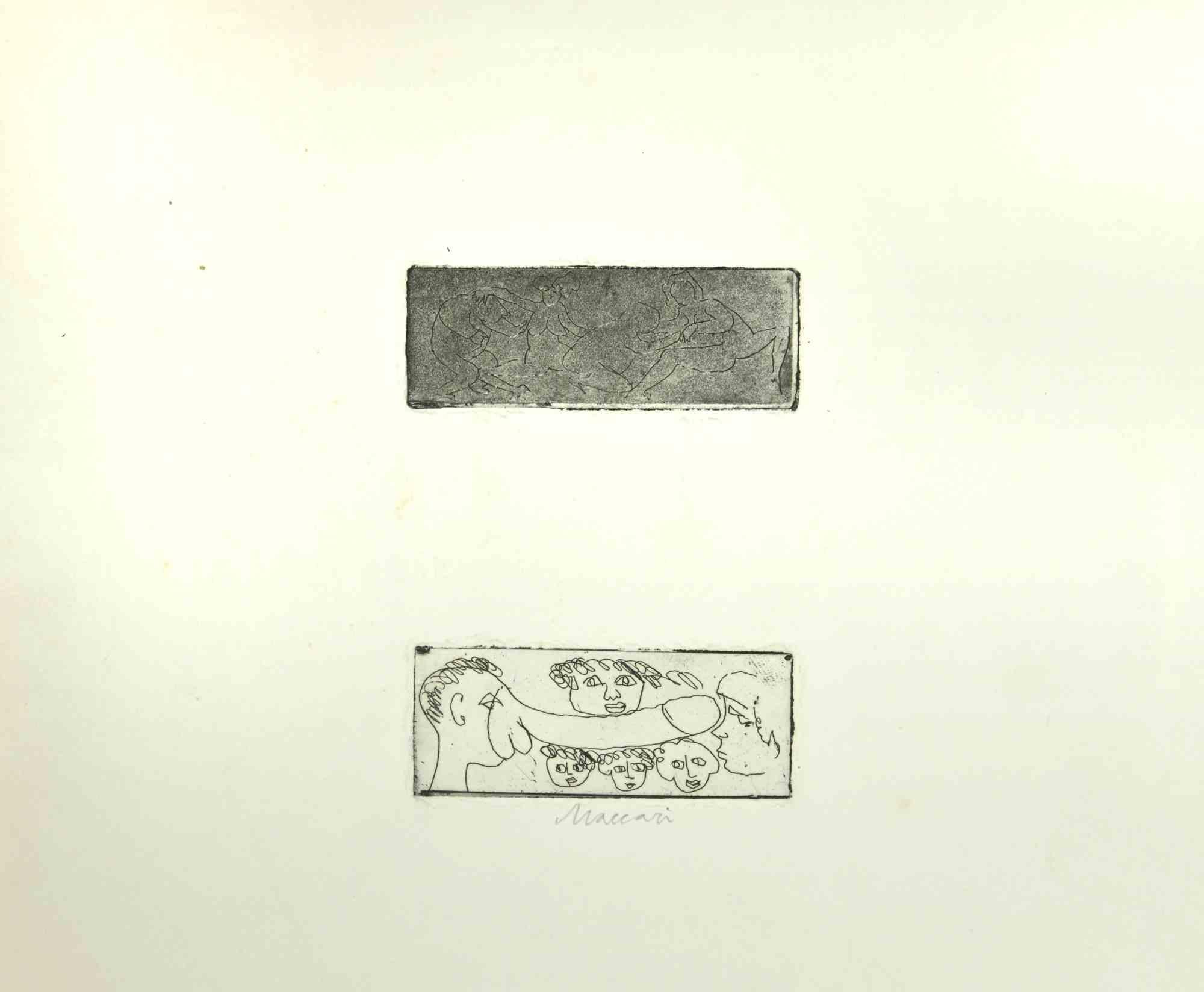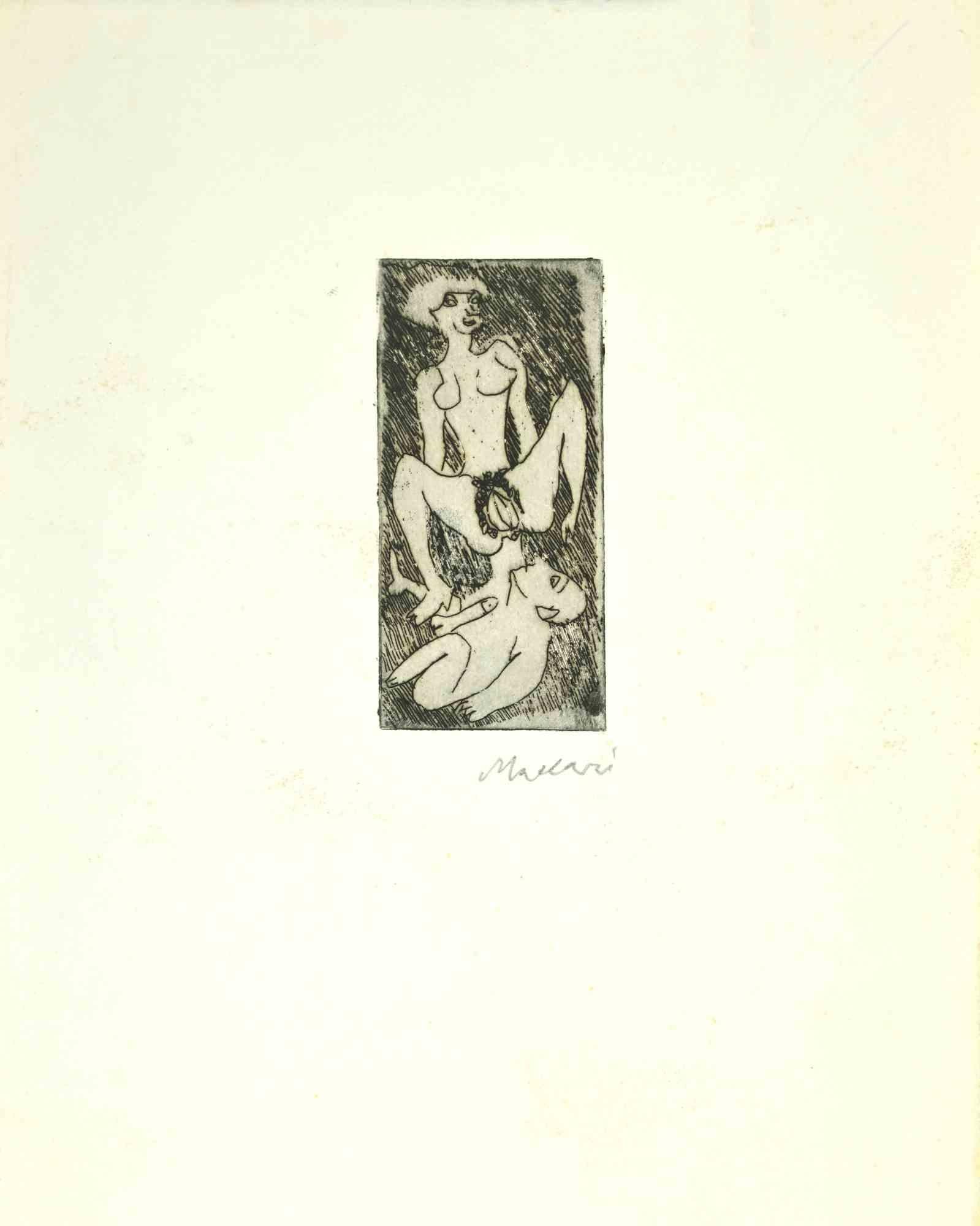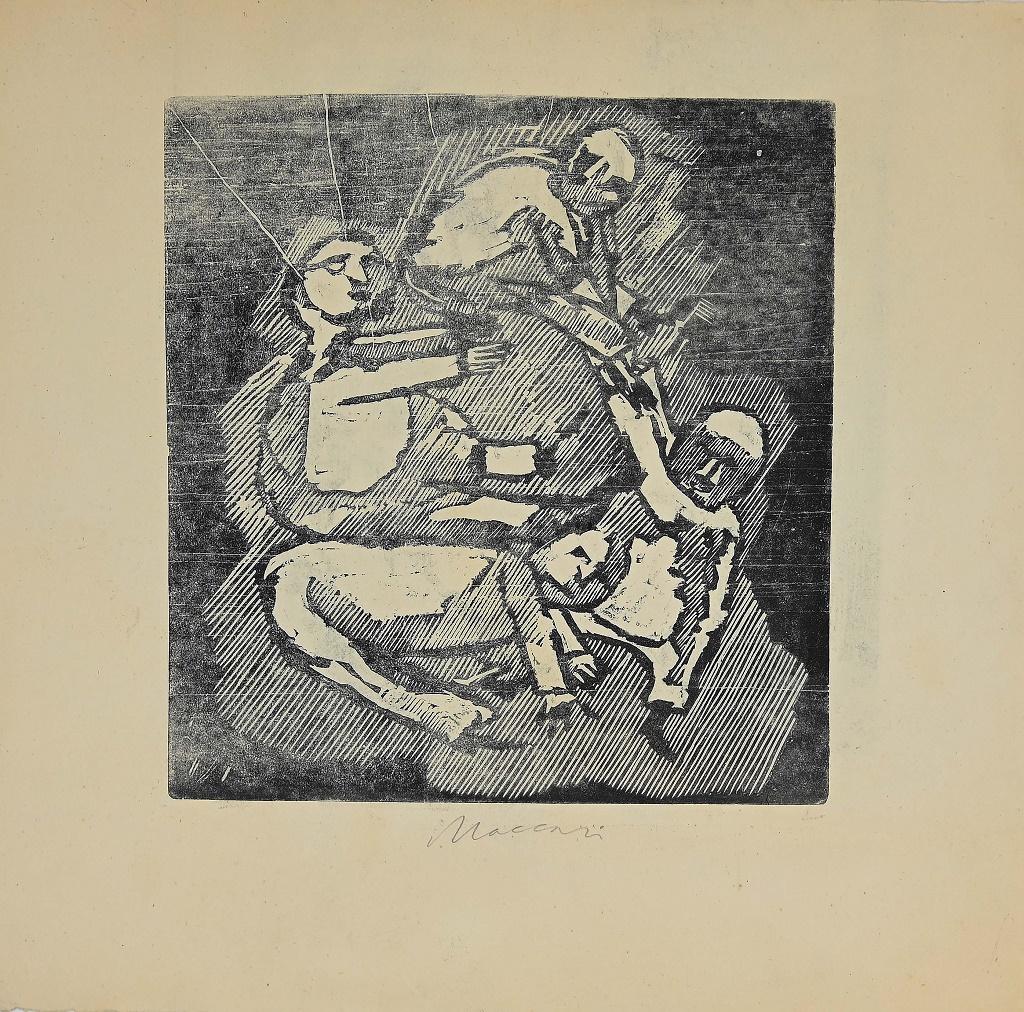Items Similar to Erotic Scene - Héliogravure by Micheal Von Zichy - 1911
Want more images or videos?
Request additional images or videos from the seller
1 of 5
Micheal Von ZichyErotic Scene - Héliogravure by Micheal Von Zichy - 19111911
1911
About the Item
Erotic scene is an original Héliogravure artwork on ivory-colored paper, realized by Micheal Von Zichy in 1911. Printed in only 300 copies, Leipzig; Privatdruck, from the Catalogue "Liebe" (Dear), Text in German on the plate, The drawing created unusually bold erotic subjects through deft strokes.
Good conditions.
Mihály Zichy (1827–1906) was a Hungarian graphic artist and painter, lived and worked in Paris and St. Petersburg. In 1853 he was appointed to the position of court artist for Alexander II of Russia.
- Creator:Micheal Von Zichy (1827 - 1906)
- Creation Year:1911
- Dimensions:Height: 11.82 in (30 cm)Width: 15.36 in (39 cm)Depth: 0.04 in (1 mm)
- Medium:
- Movement & Style:
- Period:
- Framing:Framing Options Available
- Condition:Insurance may be requested by customers as additional service, contact us for more information.
- Gallery Location:Roma, IT
- Reference Number:
About the Seller
4.9
Platinum Seller
These expertly vetted sellers are 1stDibs' most experienced sellers and are rated highest by our customers.
1stDibs seller since 2017
6,824 sales on 1stDibs
Typical response time: 3 hours
- ShippingRetrieving quote...Ships From: Grasse, France
- Return PolicyA return for this item may be initiated within 14 days of delivery.
More From This SellerView All
- Faces - Etching by Mino Maccari - Mid-20th CenturyBy Mino MaccariLocated in Roma, ITFaces is an Etching and Drypoint realized by Mino Maccari in the Mid-20th Century. Hand-signed in the lower right part. Good conditions. Mino Maccari (Siena, 1924-Rome, June 1...Category
Mid-20th Century Modern Figurative Prints
MaterialsPaper, Drypoint, Etching
- Les Fleurs du Mal - Odilon Redon - Illustration - ModernBy Odilon RedonLocated in Roma, ITThis rare 1890 edition of Les Fleurs du mal is a suite of original engravings by Odilon Redon. Complete and homogeneous series of 8 héliogravures (Ev...Category
1890s Modern Figurative Prints
MaterialsPaper, Engraving
- At the Sea - Etching and Drypoint by Mino Maccari - 1925/1930By Mino MaccariLocated in Roma, ITAt the Sea is an original drypoint realized by Mino Maccari (1925-1930). The artwork is in good conditions, except for worn paper on the margins. Hand-signed by the artist on the r...Category
1920s Modern Figurative Prints
MaterialsPaper, Drypoint, Etching
- Erotic Scene - Etching by Mino Maccari - Mid-20th CenturyBy Mino MaccariLocated in Roma, ITErotic Scene is an Etching and Drypoint realized by Mino Maccari in the Mid-20th Century. Hand-signed in the lower part. Good conditions. Mino Maccari (Siena, 1924-Rome, June 1...Category
Mid-20th Century Modern Figurative Prints
MaterialsDrypoint, Paper, Etching
- Figures - Drypoint by Mino Maccari - 1945By Mino MaccariLocated in Roma, ITFigures 1945 is an original drypoint realized by Mino Maccari (1945). The artwork is in good conditions, except for worn paper on the margins. Image Dimensions: 20x18.8 cm. Hand- ...Category
1940s Modern Figurative Prints
MaterialsPaper, Drypoint
- Figures - Drypoint by Mino Maccari - Mid-20th CenturyBy Mino MaccariLocated in Roma, ITMid-20th Century. Hand-signed in the lower right part. Numbered. Edition 1/12. Good conditions. Mino Maccari (Siena, 1924-Rome, June 16, 1989) was an Italian writer, painter, engraver and journalist, winner of the Feltrinelli Prize for Painting in 1963 and first winner of the Forte dei Marmi Satira Prize in 1973.After completing his secondary education, he enrolls in university. An interventionist like many young people of his time, he took part in the Great War at the age of nineteen as a field artillery officer. At the end of the conflict he resumed his university studies in Siena and in 1920 he graduated in law. In 1924 he was called by Angiolo Bencini to take care of the printing of the magazine Il Selvaggio, openly uncompromising fascist, revolutionary and anti-bourgeois, where his first engravings were published. After a few years of coexistence between work at the newspaper and the law firm, at the beginning of 1926 he left the legal profession to take over the direction of Il Selvaggio which he would hold until 1942. In 1928 he was the author of the small book published by Vallecchi (Florence), Il Trastullo di Strapaese (little songs and engraved woodwinds) which collected fascist songs (the same book was seized several times from Antonio Gramsci during his detention). With the transfer of the editorial staff of the Selvaggio in 1925 from Colle di Val d'Elsa to Florence, Maccari collaborated with Ardengo Soffici, Ottone Rosai and Achille Lega. In the meantime, between 1927 and 1930, he made himself known to the general public as a painter by participating in various national exhibitions. Also in 1930 Maccari works in Turin at La Stampa as editor-in-chief and has the writer Curzio Malaparte as director. His presence in the cultural and editorial world of the fascist regime is very intense, he writes and collaborates with various magazines: Quadrivio, L'Italia Letteraria, L'Italiano and Omnibus by Leo Longanesi; then, during the war, in il Primato di Bottai and, subsequently again, in Il Mondo di Pannunzio (from the first number, in 1949), up to Documento by Federigo Valli. His graphic production is also vast, ranging from the Album of Vallecchi (1925), Il trastullo di Strapaese (1928) to Linoleum (1931). Maccari illustrated in 1934 La vecchia del Bal Bullier by Antonio Baldini and in 1942 he published the Album folder, followed by Come quando fuori Piove and Il superfluo illustrata.For his pictorial work full of evident chromatic accentuations and fast brushstrokes, the violent drawing combined with the lively stroke of the graphic sign of his engravings, he is recognized by critics as a complete artist. In 1962 he was also entrusted with the presidency of the Accademia di San Luca in Rome and managed to obtain a personal exhibition at Gallery 63 in New York. His production of drawings, watercolors, temperas, etc. is endless, sometimes in collaboration with prestigious publishing houses; it is worth mentioning, just as an excellent example, the 32 b/w and color drawings with which he illustrated Il gusto di vivere, a volume that collects writings by Giancarlo Fusco, edited by Natalia Aspesi and published by Laterza in 1985. Maccari, Sienese and great contradaiolo della Torre, painted the Palio...Category
Mid-20th Century Modern Figurative Prints
MaterialsPaper, Drypoint, Etching
You May Also Like
- L'Etreinte. II (Embrace)By (after) Pablo PicassoLocated in Palo Alto, CACreated in 1933, this Etching with Drypoint on Montval laid paper is stamped by the Picasso Estate Collection via Marina Picasso on verso and is a rare proof, aside from the numbered...Category
1930s Modern Figurative Prints
MaterialsEtching, Drypoint, Laid Paper
- Steps to the Grand Canal, St. Mark's in the distance, Venice.By Donald Shaw MacLaughlanLocated in Middletown, NYA lovely view of Venice from the water. Etching with drypoint on antique cream laid paper with a large figural watermark, signed in pencil, lower right. 14 1/4 x 11 inches (362 x 280...Category
Early 20th Century American Modern Landscape Prints
MaterialsLaid Paper, Drypoint, Etching
- Victor Guadalajara, "Intersections", 2009, Woodcut 16x12inBy Victor GuadalajaraLocated in Miami, FLVictor Guadalajara (Mexican, 1965) 'Intersecciones', 2009 Woodcut and Aquatint 100.00 x 185 cm. (39.4 x 72.8 in.) Edition of 30 UnframedCategory
Early 2000s Modern Abstract Prints
MaterialsPaper, Ink, Engraving, Etching, Woodcut
- Man Unveiling a Woman, 1931 (Vollard Suite, B.138)By Pablo PicassoLocated in Greenwich, CT"Man Unveiling a Woman" is a drypoint from Picasso's Vollard Suite, image size 14.5 x 11.5 inches, signed 'Picasso' lower right and framed in a Spanish-style, closed-corner, black an...Category
20th Century Modern Prints and Multiples
MaterialsPaper, Drypoint
- Low Country (South Carolina)By Elizabeth VernerLocated in Middletown, NYAn enchanting Southern landscape by the mother of the Charleston Renaissance. A native of Charleston, South Carolina, and educated under the tutelage of Thomas Anshutz at The Pennsylvania Academy of Fine Arts, O'Neill Verner was a teacher, a mother, an artist, an ardent preservationist, and a skilled autodidact. Having previously focused on painting, in the early 1920s she found herself deeply moved by printmaking as a media, and especially so by the simple, peaceful themes and tableaus she discovered in Japanese art. She embarked on a effort to teach herself Japanese printmaking techniques, and in the process, produced the charming images of every day life in Charleston and its environs that earned her recognition as a cultural icon in her day, and in more modern times, as the mother of the Charleston Renaissance, which flourished well into the 1930s. In 1923 she opened a studio in Charleston where she focused on documenting the local color and the architecture and landscape that distinguishes Charleston as one of the South's most beautiful cities, all the while applying the gentle and poetic thematic sensibilities of Japanese printmaking. O'Neill Verner soon found herself in high demand when municipalities and institutions throughout the country sought commissions from her to document the beauty of their grounds and historic buildings. She worked as far north as the campuses of Harvard and Princeton, and extensively across the South, including in Savannah, Georgia, where through sweeping commissions she was able to marry her love of southern preservation and art. O'Neill Verner was a lifelong learner, and continued a path of edification that led her to study etching at the Central School of Art in London, to travel extensively through Europe, and to visit Japan in 1937, where she studied sumi (brush and ink) painting. She was a founding member of the Charleston Etchers Club, and the Southern States Art League. Her works are represented in the permanent collections of leading museums across the American south, and in major national institutions including the Metropolitan Museum of Art, Boston's Museum of Fine Art, and the Smithsonian American Art Museum. O'Neil Verner...Category
Early 20th Century American Modern Landscape Prints
MaterialsArchival Paper, Drypoint, Etching
- Spring Song /// Antique Female Artist Children Child Etching British ArtBy Eileen SoperLocated in Saint Augustine, FLArtist: Eileen Alice Soper (English, 1905-1990) Title: "Spring Song" *Signed by Soper in pencil lower right Year: 1924 Medium: Original Etching on cream laid paper Limited edition: 178 Printer: Likely printed by Eva Soper, London, UK Publisher: H C Dickens, London, UK Reference: "The Catalogue Raisonne of Prints and Etchings of George and Eileen Soper" - Beetles No. 83, page 119, 141, 157 Sheet size: 8.13" x 10.13" Image size: 6.63" x 9.63" Condition: Paper trimmed in the margins. A few faint areas of discoloration. It is otherwise a strong impression in very good condition Notes: Provenance: private collection - Boulder, CO. Biography: Eileen Soper was born in 1905 in the Municipal Borough of Enfield and moved to the house where she was to spend the rest of her life in Harmer Green, Welwyn in the Hertfordshire countryside in 1908. The house she later named "Wildings" was built by her father, the artist George Soper...Category
1920s Modern Figurative Prints
MaterialsIntaglio, Drypoint, Laid Paper, Etching
Recently Viewed
View AllMore Ways To Browse
Antique Erotic
Micheal Von Zichy
Used Bob Cats
Vintage Israeli Travel Posters
Vintage Marquee
Vintage Television Sets 1980s
Vintage Travel Poster Israel
Vintage Wine Maps
1940 Italian Bed
1945 Salvador Dali
Abstract Carved Bird Sculpture
Andy Warhol Sam
Antique African American Paintings
Antique Black And White Horse Prints
Antique Christmas Prints
Banjo Used
Cardinal Bird
Cat Eye Watch





